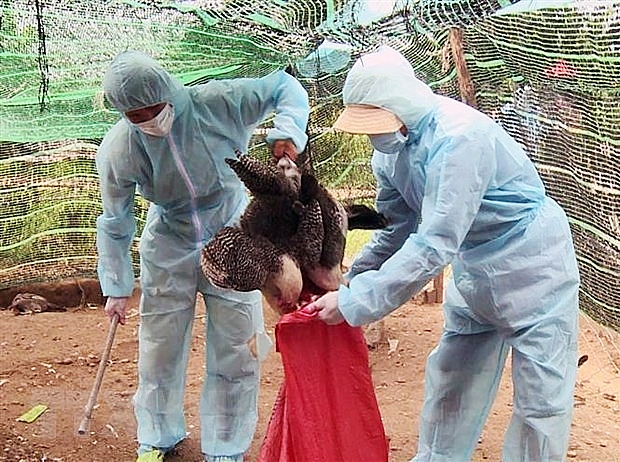Country shoring up defences amid bird flu concerns
 |
| Veterinary staff collect infected chickens.- VNA/VNS Photo The Lap |
Last week, Chinese agriculture authorities said a highly pathogenic H5N6 strain of avian flu had been found in a poultry farm in Sichuan province. This is the first H5N6 avian flu detected from a poultry farm since four cases were found in swans in January.
The ministry said on Sunday that over 1,800 birds had died in the farm of 2,500, while the rest have been culled.
Earlier this month, a city in China’s central Hunan province reported that it had culled almost 18,000 chickens after an outbreak of H5N1 bird flu. Hunan is next to Hubei, the epicentre of the separate coronavirus outbreak.
The avian influenza, found in a farm in Shaoyang city, killed 4,500 chickens, more than half the farm’s flock. The city culled almost 18,000 poultry after the outbreak. The strain is a highly pathogenic subtype of the H5N1 flu.
According to the World Organization for Animal Health, since early January, a batch of avian flu cases have been found across 11 countries and territories. Thereby, unless alerts are set for preventing an epidemic, bird flu may infect poultry in neighbouring nations such as Vietnam in the near future.
As in previous years, after the Lunar New Year, the farming household of Le Thi Hien in Quoc Oai district in Hanoi started developing her farm. Regardless of the breeding season, she also applies full disease prevention to keep the poultry healthy and gain high economic benefits for the family. However, many farming households have yet to carry out any epidemic prevention measures. Although media channels have made public all information and alerts about bird flu from China, a lot of farmers are still not careful, and not fully vaccinated.
Ngo Van Dong in My Duc district’s Huong Son commune started to raise chickens instead of pigs, which had been culled due to the effects of African swine fever (ASF) in the middle of last year. Due to poor experience on poultry farming and small quantities, he has yet to vaccinate his poultry. However, he did not imagine that if a chicken in his ownership or nearby is infected, his whole flock would be at risk, and potentially risk the rest of the country.
According to director of Hanoi Animal Husbandry and Veterinary Department Nguyen Ngoc Son, after the ASF epidemic last year, many farms shifted to poultry, so the number of such facilities in Hanoi soared sharply. The total poultry in Hanoi is estimated at over 40 million, an increase of 14.3 per cent on-year, including a rise of 26.5 million chickens, up 17.1 per cent. “The significant soar of poultry stock contains the risk of an avian flu epidemic outbreak,” said Son.
The result of testing avian flu across 26 cities and provinces, which involved 4,000 samples from nearly 20,000 poultry, confirmed that 37.7 per cent of those were positive with bird flu, including 1.2 per cent positive for the H5N1 virus, and 1.8 per cent positive with H5N6.
Last year, 70 farms in 24 Vietnamese cities and provinces were infected with bird flu, with around 133,000 poultry culled.
Previously, the H5N1 avian flu had caused a lot of damage in Vietnam. Detecting the virus initially in 2003, Vietnam was one of the first countries to suffer from an epidemic and received the most damage, with around 45 million poultry culled between 2003 and 2006. Since then, hundreds of thousands of poultry have been culled each year. During 2004-2014, as many as 127 people were also infected, including 64 deaths involving H5N1 bird flu.
Currently, avian flu has broken out in small-scale farms, and as yet there are no statistics on damage to livestock companies such as C.P. Vietnam and Mavin, as these enterprises provide careful preparations and forecasts in order to prevent the disease.
Japfa Comfeed is another example. According to Phung Hang, technical expert at Japfa, told VIR that in the context of the increase of diseases, especially ASF, biosafety is considered one of the top priorities to control the expansion of epidemics, save expenditure for veterinarians, and improve breeding effectiveness.
“Along with biosafety solutions, we are proactive in preventing diseases such as H5N1 via complying with vaccine injection calendars and training farmers about the importance of such measures,” said Hang. “The company has assigned technical teams to periodically test blood models and the health of the poultry herd.”
Hang told VIR that Japfa believes prevention is better than the cure, and it is also the cheapest solution. In addition, in order to help the poultry herd maintain good health they have to have strong resistance, which depends partly on feed. “Along with breeding, delivery is also important because it is also a factor that contributes to the spread of viruses,” Hang added.
What the stars mean:
★ Poor ★ ★ Promising ★★★ Good ★★★★ Very good ★★★★★ Exceptional
Related Contents
Latest News
More News
- Vietnam’s green transition demands collective financial action (December 15, 2025 | 12:00)
- VIR workshop highlights capital and policy for sustainable development (December 15, 2025 | 11:00)
- National Assembly approves pilot mechanisms to accelerate major projects in Hanoi (December 12, 2025 | 11:29)
- Vietnam eases policy approval requirements, simplifies foreign and outbound investments (December 11, 2025 | 17:53)
- Unpacking new momentum in Vietnam’s M&A market (December 10, 2025 | 09:59)
- Forum honours outstanding M&A deals, strategies, and advisory firms (December 09, 2025 | 18:22)
- Vietnam enters defining phase of M&A growth (December 09, 2025 | 17:00)
- Vietnam’s M&A market opens new opportunities amid strong economic momentum (December 09, 2025 | 15:00)
- Vietnam M&A Forum 2025: new position, new momentum (December 09, 2025 | 14:30)
- FDI in Vietnam jumps on additional capital and share purchases (December 09, 2025 | 13:56)

 Tag:
Tag:






















 Mobile Version
Mobile Version